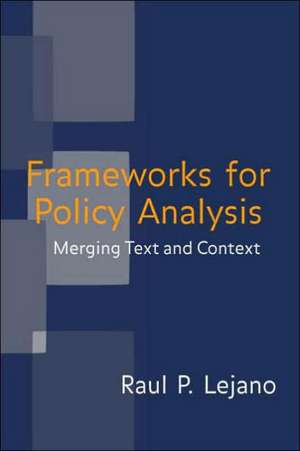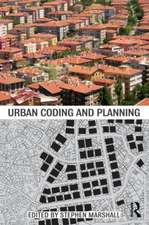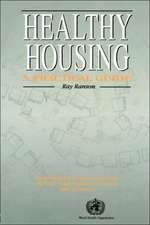Frameworks for Policy Analysis: Merging Text and Context
Autor Raul P. Lejanoen Limba Engleză Hardback – 21 mar 2006
| Toate formatele și edițiile | Preț | Express |
|---|---|---|
| Paperback (1) | 449.45 lei 6-8 săpt. | |
| Taylor & Francis – 15 mar 2006 | 449.45 lei 6-8 săpt. | |
| Hardback (1) | 935.29 lei 6-8 săpt. | |
| Taylor & Francis – 21 mar 2006 | 935.29 lei 6-8 săpt. |
Preț: 935.29 lei
Preț vechi: 1255.92 lei
-26% Nou
Puncte Express: 1403
Preț estimativ în valută:
178.97€ • 191.38$ • 149.22£
178.97€ • 191.38$ • 149.22£
Carte tipărită la comandă
Livrare economică 17 aprilie-01 mai
Preluare comenzi: 021 569.72.76
Specificații
ISBN-13: 9780415952750
ISBN-10: 0415952751
Pagini: 280
Ilustrații: 41 b/w images, 17 tables and 22 halftones
Dimensiuni: 152 x 229 x 23 mm
Greutate: 0.68 kg
Ediția:1
Editura: Taylor & Francis
Colecția Routledge
Locul publicării:Oxford, United Kingdom
ISBN-10: 0415952751
Pagini: 280
Ilustrații: 41 b/w images, 17 tables and 22 halftones
Dimensiuni: 152 x 229 x 23 mm
Greutate: 0.68 kg
Ediția:1
Editura: Taylor & Francis
Colecția Routledge
Locul publicării:Oxford, United Kingdom
Notă biografică
Raul Lejano is Professor in the School of Culture, Education, and Human Development at New York University. He has authored/co-authored close to a hundred peer-reviewed articles and five books, including A Phenomenology of Institutions: Relationality and Governance in China and Beyond (Routledge).
Cuprins
Introduction Part I Positivist Foundations of Policy Analysis Chapter 1 Background: Origins of the Classical Model Chapter 2 Decisions Chapter 3 Games Part II The Postpositivist Turn Chapter 4 Background: Voices of Postpositivism Chapter 5 Text Chapter 6 Critique Chapter 7 Ethics Part III The Postconstructionist Sentiment Chapter 8 Background: Grounding the Discourse Chapter 9 Experience Chapter 10 Coherence Chapter 11 Topology Bibliography Index
Descriere
Frameworks for Policy Analysis </EM>argues that, in order to bring relevance back to policy analysis, we need to approach policy situations as complex phenomena and employ multiple ways of looking at things in order to understand the essential elements of each policy case. The book is an exploration of distinct, sometimes radically different, models for analysis, but it is also a reference for these multiple methodologies that all come under the term "analysis." Along with classic and recent models, the book introduces some new concepts that serve to deepen our analysis and aspire to what Geertz calls "thick description." This text, written for advanced courses in policy analysis, is an answer to the critical gap between the complexity and dimensionality of policy situations and the abstract and formal character of policy analysis, in general. The book begins by introducing the reader to dominant models of analysis, pointing out their limitations and the potential for transcending these limits. It also introduces new analytical approaches that help to merge text and context, increasing the dimensionality and authenticity of the analysis.


















